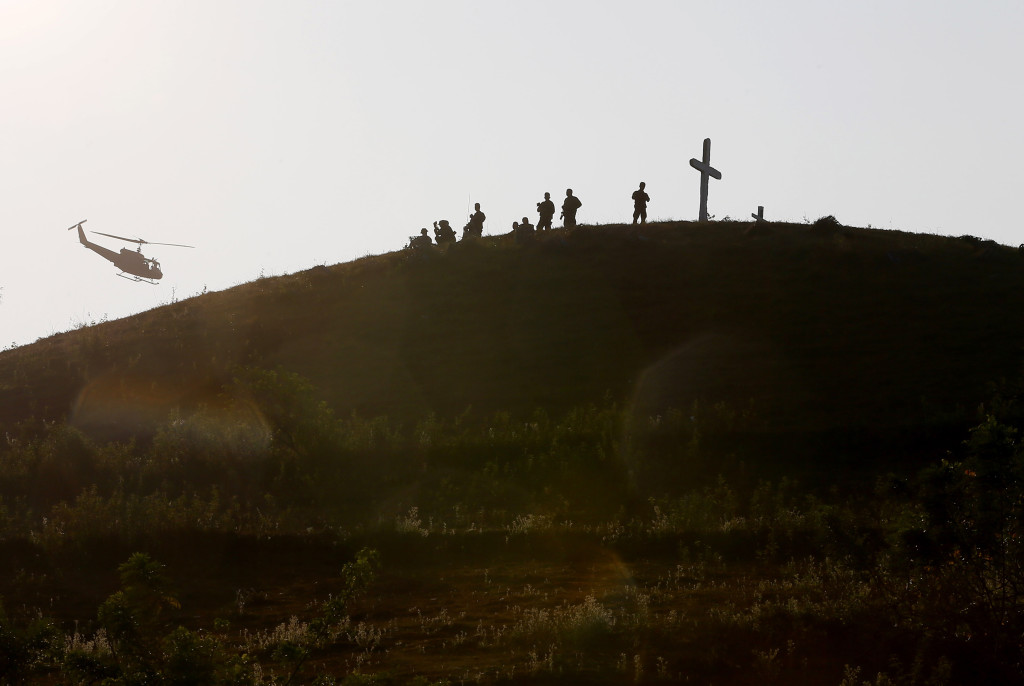Chinese military plane lands on disputed reef

In this April 14, 2016, file photo, Philippine troops man their positions on top of a hill during joint U.S.-Philippines military exercises at Crow Valley, Philippines. With tensions rising in the South China Sea, The Pentagon said that nearly 300 American troops will remain in the Philippines through the end of the month following annual war games that ended Friday. (AP Photo/Bullit Marquez, File)
BEIJING—A Chinese military aircraft has for the first time publicly landed at a new airport on an island that China has built in the disputed South China Sea, state media said on Monday, raising the prospect that Beijing could base fighter jets there.
The United States has criticized China’s construction of artificial islands in the South China Sea and worries that Beijing plans to use them for military purposes, even though China insists it has no hostile intent.
The runway on Fiery Cross Reef is 3,000 meters (10,000 feet) long and is one of three that China has been building for more than a year by dredging sand up onto reefs and atolls in the Spratly archipelago.
Civilian flights began test runs there in January.
In a front-page story, the official People’s Liberation Army (PLA) Daily said a military aircraft on patrol over the South China Sea received on Sunday an emergency call to land at Fiery Cross Reef to evacuate three seriously ill workers.
The three workers were reportedly taken by the transport plane back to Hainan island for treatment, the newspaper said, showing a picture of the aircraft on the ground in Hainan.
The Global Times tabloid said Sunday’s flight marked “the first time a Chinese military plane has openly landed on Yongshujiao,” using the Chinese name for Fiery Cross Reef.
The speed with which the mission was accomplished was a testament to China’s long-term policy of patrolling over the South China Sea, according to the tabloid published by the ruling Chinese Communist Party’s mouthpiece, People’s Daily.
The paper cited a military expert as saying the flight showed the airfield was up to military standards and could see fighter jets based there in the event of war.
The runways would be long enough to handle long-range bombers and transport aircraft as well as Beijing’s best jet fighters, giving China a presence deep in the maritime heart of Southeast Asia that it has lacked until now.
Military drills
China’s South China Sea fleets earlier conducted training drills with upgraded methods that resemble actual combat conditions to increase the fleets’ combat effectiveness, according to an article published by the PLA Daily on Sunday.
Begun on April 7, the drills include new methods such as training within an electromagnetic environment. Previously, the fleets have also conducted all-weather drills, beyond visibility range training and low-altitude, high-speed exercises to hammer their pilots into shape, the article said.
“To think about special situations in an even more complex way, to make the enemy situation even more dangerous, to make the battlefield environment even more lifelike, is an important path in order for the Navy and Air Force to stick close to the demands of real combat and accelerate its transformative production model for fighting strength,” a division commander, Tian Junqing, was quoted as saying.
The article did not specifically say where in the South China Sea the drills took place.
China’s naval fleets will further explore 24-hour maritime attack drills, minimum altitude defensive dashes and other military tactics, the article added.
The fleets also will work in coordination with early aerial warnings, surface ships and ground antiaircraft defense, among other branches of the military.
Complaints
China claims most of the South China Sea, through which more than $5 trillion in global trade passes every year. Its Southeast Asian neighbors—the Philippines, Vietnam, Brunei and Malaysia—also claim part of the strategic waterway, as does Taiwan.
Vietnam has accused China of threatening the safety of civilian flights by failing to properly inform its aviation authorities of the flights beforehand.
The United States also has complained that the flights raised tensions and has reiterated its calls for a halt to land reclamation and militarization of outposts in the area.
The Philippines, which also claims islands and reefs controlled by China, has also criticized Beijing’s moves.
Tensions have risen in the last two years after China transformed Kagitingan (Fiery Cross) Reef and other coral reefs in the Spratly Island chain into islands that could be used to project its military might far from the Chinese mainland.
The new islands in the South China Sea have become a source of tension between Beijing and Washington, which refuses to view them legally as islands entitled to territorial seas and special economic zones.
While the United States is not a claimant state, Washington says it has a national interest in the peaceful settlement of disputes in the South China Sea and in freedom of navigation in waters that are critical for world trade. Reports from the wires
For comprehensive coverage, in-depth analysis, visit our special page for West Philippine Sea updates. Stay informed with articles, videos, and expert opinions.